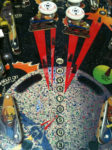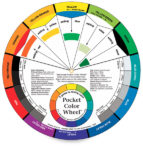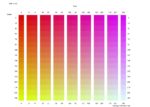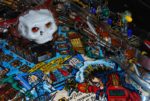Matching Paint Colors
This article was originally posted on PinballRehab.com.
Reproduced with permission from terryb.
Written by terryb

There’s nothing worse than a game where someone did some touch-up paint and didn’t match the paint color very well (see Image 3). While it does take a good eye to match paint colors there are also some tools and techniques available that will make your life easier.
See Images 4 and 5 for an example of some touch-up paint I did on the scoop hole on a Data East Hook.
General Advice
Not to be sexist here, but women are generally much better at matching colors than guys are. So if you’re a guy, get your wife or girlfriend to give you a hand.
Whenever possible paint to the borders (the black line typically printed around colored areas). If you try to paint just a portion of a red area your color match has to be exact. On the other hand, if you can paint the entire red area you can be a few shades off and no one will ever know.
When matching paint colors always use color samples with the same gloss as the area you will be painting. If you don’t you’ll be quite a bit off when the job is completed.
Lighting will dramatically change the look of colors so use good quality, consistent, lighting. Avoid LED and fluorescent.
Consider the Media
The type of media you will be using makes a difference as to how you match colors. If you’re planning on doing touch-up paint see this section. If you’re going to be printing decals on your personal printer see this section. If your plans are to use a sign or print shop to create the decal see this section.
Painting – Quick Solutions
For a quick solution, there are a couple of online resources that either sell pinball paint or provide suggested paint matches. Be aware though that every game has aged differently so paint that matches one game may not match another.
Pinball Universe sells a few hard to match cabinet paints like the lightning blue color on Addams Family.
You could also try posting on the Pinside forum and see if someone else has matched the color you’re looking for.
Note: Due to fading and variations in the original paint batches, you will probably still have to tweak any paint obtained via these methods.
You might get lucky if you go to your local paint/hardware store and grab a bunch of paint chips. I’ve actually gotten a match a couple of times this way. [Editors note: We have taken color parts from a pinball machine and had them matched at Lowes or Home Depot with excellent results. It can be a little strange walking in with a backbox or a playfield, but it works.]
Painting – Pantone
Pantone is most famous for creating the Pantone Matching System (PMS). The idea behind PMS is to allow designers to color match specific colors regardless of the equipment used to produce the color. In other words, you can go to any quality printing shop, paint store or fabric shop and request a specific Pantone color and they will each match exactly.
The one drawback is that there are only a few thousand Pantone colors whereas there are millions of possible color combinations.
 The Pantone Formula Guide can be used to match Pantone colors (see Image 1). Since a lot of games where originally silk-screened with ink (although it may not have been Pantone ink) you’ve often got a good shot of finding a match with this technique.
The Pantone Formula Guide can be used to match Pantone colors (see Image 1). Since a lot of games where originally silk-screened with ink (although it may not have been Pantone ink) you’ve often got a good shot of finding a match with this technique.
Since designers replace their Pantone Formula Guides every year, they can be picked up fairly cheap on eBay. Although Pantone has a variety of guides you want to get either the Formula Guide Solid Coated or Uncoated. Use the coated guide for glossy paint and the uncoated guide for matte paint. The newer guide (Pantone Plus) has 336 additional colors.
If you find a match with the Color Guide you can either order the paint color from a Pantone reseller or have your local paint store match the swatch on the color guide. Some high-end paint stores will be able to create the paint directly from the Pantone color code.
If your paint store can work with RGB or Lab (most can’t) you can use a Pantone-Color-Chart to translate a PMS color.
Once you have the RGB number you can use the EasyRGB website to search for off the shelf colors from a variety of brands. Be aware though this method may move you farther away from the desired color.
Painting – Dulux
If you’re lucky enough to live in Canada, Dulux has a pretty slick method for matching paint. All you have to do is print out the Dulux Color Frame and take a picture of it and the paint you are trying to match. Upload the image and they will respond with the closest Dulux paint match.
I have not tried this so can’t tell you how it works, but be aware it has the same limitation as Pantone in regards to the number of Dulux paint colors.
Painting – Colorimeter
One of the easiest, although destructive, ways to match paint is by getting a color chip from the cabinet and having your local paint or hardware store match it using their colorimeter. Just carefully remove a one inch square of each color you need and then patch the area. While it would be nice to do this under a leg, usually that area is not as faded as the rest of the cabinet.
Obviously this is not a good choice for playfields.
The quality of the chip is very important and needs to have a flat surface and be completely covered with a good example of the color you need.
While there are portable colorimeters available they are fairly expensive. The only reasonably priced model is the Color Cue from Pantone (you can pick one up used for less than $150), but it only matches to the closest PMS color. The earlier version, Color Cue 1.0, can provide actual RGB readings with some tweaking (see this article).
Most of the major paint companies offer iPhone, or smart phone, apps for matching to their paint colors (Pantone, Sherwin Williams, Behr, Olympic, Sherwin William, Valspar, etc.). Or you can get the AnyPaintColor app from MyPerfectColor for $2.99, which will match to most brands of paints (see reviews).
Unfortunately none of these are really very accurate at matching colors. For example, I bought the Pantone iPhone app and used it on my Pantone Color Guide. and it was seldom even close to picking the right PMS color.
I guess you could use one to get a starting point, but that’s about it.
Painting – Mixing
Personally I prefer mixing my own paint colors when doing touch-ups as I have the supplies on hand and can get a better match. Even if you are using one of the techniques above, the paint may still require a little tweaking to get a perfect match (other than the colorimeter, which should give you a very good match).
I prefer Createx airbrush paints or Testors acrylic. For a wider variety of color choices you can use acrylic hobby paints (although I don’t recommend this since they fade faster than other paint choices). If you use hobby paints stay away from store brands since they generally have a low pigment content. I find Liquitex (technically an artist paint, rather than a hobby paint) to be the best brand although it’s slightly more expensive.
Note: The best prices and selection I’ve found on Createx paints are at Dick Blick. They also carry the 16oz bottles.
Be aware of gloss differences between the sample and color you’re matching, especially when using hobby or artist paint (since they’re not as glossy). Once you get close to the color you need to either spray some gloss or semi-gloss clear over the sample or wipe it with Naptha.
See the references for more info on types of paint and sheen (glossiness).
When testing your color match, the material you paint a sample on affects the result. I typically use a cardboard box with a white gloss finish for bright colors and a cardboard box with gray primer for dark colors (see note below about primers).

There’s not a lot of advice I can give you when mixing your own paint colors. Start with a color that’s close to what you need and then it just takes patience and a good eye. It’s worth picking up a color wheel (see Image 6) at your local crafts store. It will aid greatly in knowing which colors to mix together to create other colors.
Once you’ve got the hue correct you can use white and black paint to adjust the value (lightness/darkness). See video at the bottom of the article. You can also use a second type of color wheel (see Image 7) for identifying the value of a color.

When adding small amounts of paint to your mixture use the back-end of a paint brush, toothpick or pipette. I typically use syringes so I can accurately measure the percentages and then make a larger batch or reproduce it in the future.
If you’re having trouble give this technique a try. Place a sample of your dried paint mixture next to the area you will be painting and take a photo (lighting is critical, so do not take two separate photos). Then open the image in your favorite graphics editing package and compare the RGB readings of the two colors.
It also helps sometimes to place a pure white sticky dot and a pure black dot (available at your local office supplies store) in the photo. Then use “Levels Adjustment” (see Editing Graphics with Bitmap Software) in your graphics program.
If the cabinet color is 200 red, 200 green and 200 blue and your mixture is 180, 200, 200 then you need to add a little red paint. Note: The RGB number will not be an accurate representation of the color (since cameras don’t really do a great job of matching colors), but the relativity of the numbers will be sufficient for this purpose.
In other words, while the color readings may not be accurate both the sample and the target should be off in the same way.
If you’re using the above technique use primary colors for red, yellow and blue (100% red, yellow or blue pigment). Testors and most hobby acrylics will have colors that are labeled as Primary Red, Primary Yellow and Primary Blue.
Note: Some bright are almost impossible to match (or to get to cover) without a primer underneath. Using a white primer will brighten up the color and solve the problem.
Printing Decals
Printing decals requires a different technique since every (non Pantone type) printer will vary widely in regards to its color representation. In other words, RGB 200, 200, 200 will come out looking completely different on three different printers. The color will even change slightly on a single printer after the color ink cartridge is replaced.
If you’re going to print your decal in high, or photo, quality use the same setting when matching colors. Since decal paper is expensive I print my initial color samples on photo paper or lay a transparency over the printout (a clear plastic sheet like we used on overhead projectors in the old days). Then as you start getting closer to your color match, print your samples on decal paper and apply the sealing coat.
For my first pass at matching colors I use a PDF version of the Pantone Color Guides that I’ve printed on my printer (you can download the PDF file here). After printing I apply a gloss (or semi-gloss) laminate to protect the pages and provide the proper sheen.
Note: If your graphics editing software uses it’s own color management system print the PDF from your graphics program.
If you find a color that’s close you can then use the camera technique I described above and then start slightly modifying the color to match.

Thanks to Reel Pinball for developing a very slick way of matching colors with your printer. First download this ColorBook PDF or this zip file and print out the pages/images. The Color Book has 4,096 color samples spread over 18 pages/images (see sample in Image 2). After printing, cut out between the columns of colors with an X-Acto knife.
If you lay a transparency over a page from the Color Book you can simulate a gloss or semi-gloss finish.
Note: If your graphics editing software uses it’s own color management system print the PDF or images from your graphics program.
Place the pages over the cabinet or playfield until you find the closest match. To further refine your choices enter the values for the closes match on the ColorBook (link to Pinball Reel tools page on TheWayBackMachine is here). This will give you a strip of 27 shades of the selected color. For further information see the Pinball Reel instruction page.
See the references for more information on printing water slide or vinyl decals.
Sign Shop
If you’re going to use a print or sign shop to print your decals it’s best to work with Pantone colors. That is the only way to ensure that they will exactly match the color you expect.
If your graphics editing software does not support Pantone Colors just give your image file to the printer and explain which colors in your file are which Pantone colors. They may charge you a few bucks to edit the image, but it won’t be much. You can make the process easier if you put each color on a different layer.
If the color you need isn’t close to any of the Pantone Colors discuss it with the Sign Shop. Typically if you provide a sample of the color you want they can do a good job of matching it. If you can’t get a sample, have them print out some color swatches you can use to match colors.
Comments
We are always looking for comments, including suggestions, improvements, errors, etc. for this page (see below).
If you have a specific question about your game that does not directly apply to this page, please see our FAQ section.


Interesting guide, thanks. You might want to know the Color Strips tool on the archived Pinball Reel tools page only produces a 000-000-000 card, so effectively isnt working.
Thanks for letting us know. I think we found a good link to a ‘ColorBook’. Please let us know if this works for you.